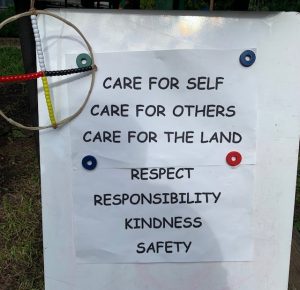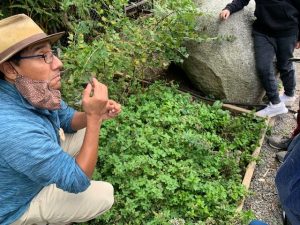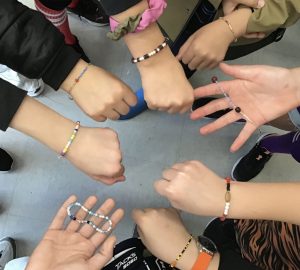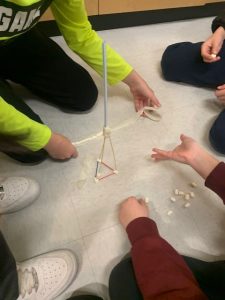Monday was our first Roots2Grow session with Pablo in our school garden. Our focus for this session was “Care for Self, Care for Others, and Care for the Land.”
 First we looked at the Medicine Wheel, which symbolizes life in a continuous natural cycle. The Medicine Wheel represents the four directions, the four seasons, the four elements, and all of humanity. People are part of the Earth, just as are the plants, animals, air, water, and rocks around us. It is important that we establish healthy relationships with all of these parts.
First we looked at the Medicine Wheel, which symbolizes life in a continuous natural cycle. The Medicine Wheel represents the four directions, the four seasons, the four elements, and all of humanity. People are part of the Earth, just as are the plants, animals, air, water, and rocks around us. It is important that we establish healthy relationships with all of these parts.
Gardening is a living process that responds to the natural cycle. The school garden is a small ecosystem that will succeed if we watch and take cues from the natural world. We do not need to be “perfect” gardeners (who is “perfect” anyway?!), but we can grow as gardeners simply by learning from what we are doing and what we have done in the past.
Our world is currently in a state of environmental crisis caused by past human actions. We must learn to care for ourselves, care for others, and care for our land in order to develop practices and take action to conserve and restore our natural resources.
 Pablo reviewed the expectations for the garden, and then we got to work harvesting quite a few different types of vegetables!
Pablo reviewed the expectations for the garden, and then we got to work harvesting quite a few different types of vegetables!
We collected:
- Peas
- Beans
- (Tiny) carrots
- Oregano
- Radishes
- Mint
- Lettuce
- Spinach
Which veggie was your favourite?
Did you do anything with it (like add it to some cooking or put in a smoothie)?
 In September students learned how to write numbers in binary (a base-2 number system). Today students learned that letters can also be coded in binary! Each student mapped out their names on grid paper, chose their colours, and beaded their names into a bracelet.
In September students learned how to write numbers in binary (a base-2 number system). Today students learned that letters can also be coded in binary! Each student mapped out their names on grid paper, chose their colours, and beaded their names into a bracelet.





 First we looked at the Medicine Wheel, which symbolizes life in a continuous natural cycle. The Medicine Wheel represents the four directions, the four seasons, the four elements, and all of humanity. People are part of the Earth, just as are the plants, animals, air, water, and rocks around us. It is important that we establish healthy relationships with all of these parts.
First we looked at the Medicine Wheel, which symbolizes life in a continuous natural cycle. The Medicine Wheel represents the four directions, the four seasons, the four elements, and all of humanity. People are part of the Earth, just as are the plants, animals, air, water, and rocks around us. It is important that we establish healthy relationships with all of these parts. Pablo reviewed the expectations for the garden, and then we got to work harvesting quite a few different types of vegetables!
Pablo reviewed the expectations for the garden, and then we got to work harvesting quite a few different types of vegetables!